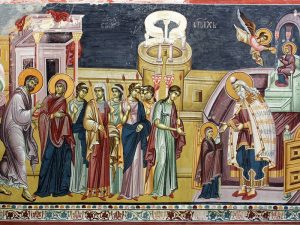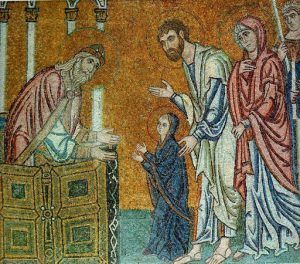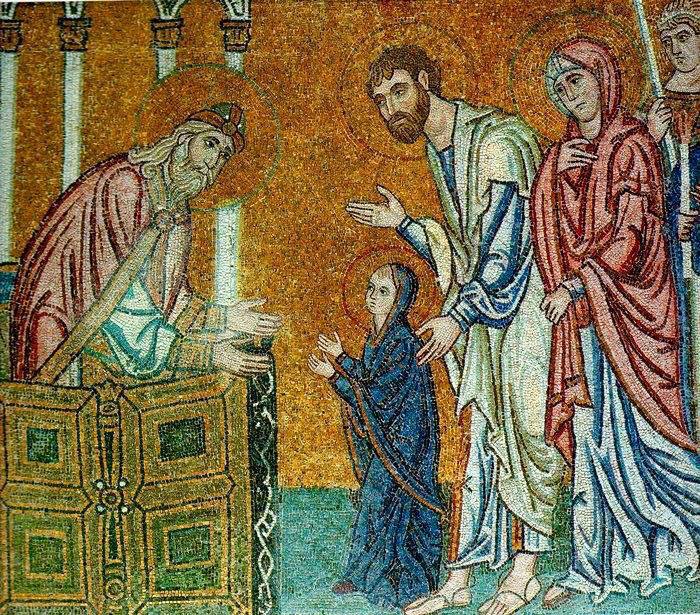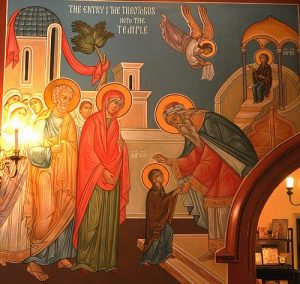 “Seeing the entrance of the pure one, angels marveled in wonder how the Virgin could enter the holy of holies.” (Refrain to Irmos 9, on the feast of the Entrance of the Theotokos into the Temple)
“Seeing the entrance of the pure one, angels marveled in wonder how the Virgin could enter the holy of holies.” (Refrain to Irmos 9, on the feast of the Entrance of the Theotokos into the Temple)
“Entrances” are a big deal in our liturgical tradition, (e.g., the Small Entrance and Great Entrance at Divine Liturgy), surrounded by great solemnity. Why? Because they are “transitional” moments; that is to say, they signify the most crucial and challenging aspect of life in general, and life in Christ more specifically – transitions. We “enter” any given day, for example, transitioning from nighttime not instantly, but by going through our morning “ritual” (getting out of bed, washing up, praying, making coffee, getting dressed, exercising, etc.). We also “enter” into communion with Christ, again and again, not instantly, but step by step, preparing ourselves with the help of traditional prayers and customs.
The feast we’re celebrating today on the Older Calendar focuses on “entrance,” the Entrance of the Theotokos into the Temple. Similar to the entrances mentioned above, Her “entrance” into “the holy of holies” involves both preparation and transition. She is to be prepared, in the temple, for the pivotal moment in Salvation History, the descent upon Her of the Holy Spirit and conception, in Him, of God the Word. There is so much more to say on this topic, on how daunting and even potentially terrifying this “transition” was, for the three-year-old Mary from Nazareth, but this reflection is already too long.
So I’ll just say, let our Lady’s courageous “entrance” today be an inspiration and encouragement for all my entrances and other transitions. Let me not fear them but walk through them, by the protection and guidance of the Blessed among Women. Amen!
Meditation by Sr. Vassa Larin
(Please note, you can get these reflections daily via EMAIL, simply by typing in your email-address at our website: www.coffeewithsistervassa.com)
 Tomorrow, November 21, is a holy day. The Divine Liturgy will be served at 9:00 a.m. in both English and Ukrainian.
Tomorrow, November 21, is a holy day. The Divine Liturgy will be served at 9:00 a.m. in both English and Ukrainian. “Seeing the entrance of the pure one, angels marveled in wonder how the Virgin could enter the holy of holies.” (Refrain to Irmos 9, on the feast of the Entrance of the Theotokos into the Temple)
“Seeing the entrance of the pure one, angels marveled in wonder how the Virgin could enter the holy of holies.” (Refrain to Irmos 9, on the feast of the Entrance of the Theotokos into the Temple) And the child was three years old, and Joachim said: Invite the daughters of the Hebrews that are undefiled, and let them take each a lamp, and let them stand with the lamps burning, that the child may not turn back, and her heart be captivated from the temple of the Lord. And they did so until they went up into the temple of the Lord. And the priest received her, and kissed her, and blessed her, saying: The Lord has magnified your name in all generations. In you, on the last of the days, the Lord will manifest His redemption to the sons of Israel. And he set her down upon the third step of the altar, and the Lord God sent grace upon her; and she danced with her feet, and all the house of Israel loved her. And her parents went down marveling, and praising the Lord God, because the child had not turned back. And Mary was in the temple of the Lord as if she were a dove that dwelt there, and she received food from the hand of an angel.”
And the child was three years old, and Joachim said: Invite the daughters of the Hebrews that are undefiled, and let them take each a lamp, and let them stand with the lamps burning, that the child may not turn back, and her heart be captivated from the temple of the Lord. And they did so until they went up into the temple of the Lord. And the priest received her, and kissed her, and blessed her, saying: The Lord has magnified your name in all generations. In you, on the last of the days, the Lord will manifest His redemption to the sons of Israel. And he set her down upon the third step of the altar, and the Lord God sent grace upon her; and she danced with her feet, and all the house of Israel loved her. And her parents went down marveling, and praising the Lord God, because the child had not turned back. And Mary was in the temple of the Lord as if she were a dove that dwelt there, and she received food from the hand of an angel.” The feast today is the story of our salvation through the temple of God.
The feast today is the story of our salvation through the temple of God.